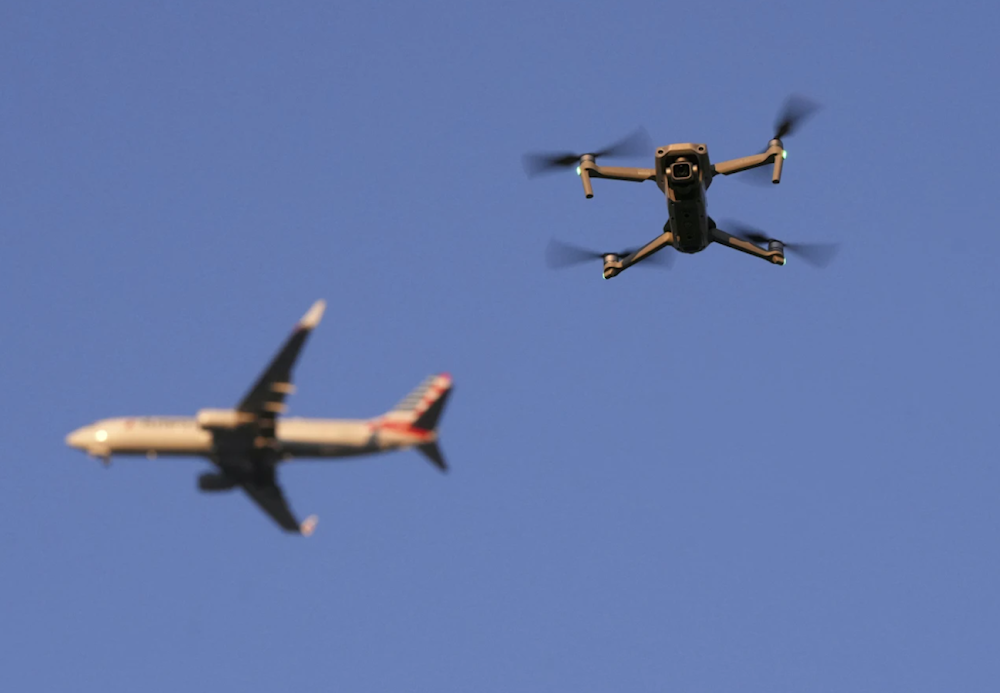US Army shifts to drone warfare in biggest revamp since Cold War: WSJ
Developed over a year of testing at US and Bavarian bases, the initiative draws heavily on Ukraine’s use of drones, which has reshaped modern combat.
-

A drone hovers in airspace outside the safety perimeter surrounding St. Louis Lambert International Airport as an airliner approaches for a landing on March 10, 2025. (AP)
The US Army is undergoing its most significant transformation since the Cold War, aiming to equip each combat division with approximately 1,000 drones while phasing out outdated weapons and equipment.
This initiative, developed over more than a year of testing at a major training facility in Bavaria and other US bases, is heavily influenced by battlefield insights from the war in Ukraine, where widespread use of small drones has reshaped combat operations.
If implemented, the plan would see the army’s 10 active-duty divisions rely extensively on unmanned aircraft for surveillance, logistics, and offensive missions.
Lessons from Ukraine, push for drone warfare integration
To better understand the lessons from the war in Ukraine, US military officers have debriefed Ukrainian personnel and consulted with defense contractors who have supported Kiev’s forces in their innovative drone operations.
Col. Donald Neal emphasized the need for the US Army to expand and integrate drone use in combat, noting that while drones have been used before, they’ve remained limited in number and scope.
Drones have revolutionized modern warfare due to their low cost and ability to swarm targets, overwhelming traditional defenses.
Where drone warfare shift all started: Hohenfels training area
This push toward drone integration was evident in February during a training exercise where a brigade from the 10th Mountain Division faced off against a simulated adversary. Once a Cold War-era site for rehearsing large-scale tank battles, the expansive Hohenfels training area has now shifted focus to modern conflict.
In this updated scenario inspired by Ukraine’s battlefield tactics, small drones flew through the overcast winter skies, piloted by soldiers and defense contractors maneuvering through the muddy terrain below.
The frigid temperatures caused ice to accumulate on some drone rotor blades and drained their batteries, issues that hadn’t surfaced during prior training in warmer climates like Hawaii and Louisiana. Soldiers scrambled to recharge the batteries in an effort to keep the drones airborne.
With low cost, swarming ability, drone warfare changes nature of conflicts
While Ukrainian and Russian forces continue to engage with traditional weapons such as artillery, armored vehicles, and manned aircraft, analysts note that drones have fundamentally changed the nature of the conflict. Their low cost, ability to swarm and overwhelm defenses, and capacity to stream live video make it far harder for troops to remain concealed on the battlefield.
Drones are just one element of a broader effort by the army to strengthen its ability to deter adversaries like Russia and China, following years focused on counterinsurgency operations in the Middle East and Central Asia.
Drone warfare: Modernization efforts, cost-saving strategies
The army is also working to enhance battlefield connectivity using smartphones, tablets, and internet-based systems and is introducing a new infantry squad vehicle. Additionally, it plans to invest around $3 billion to improve defenses against enemy drones and expand its electronic warfare capabilities.
The modernization effort is expected to cost $36 billion over the next five years. To fund it, the army intends to cut outdated weapons and retire legacy systems, a strategy that will require congressional approval.
'Army Transformation Initiative'
The army’s strategic blueprint, known as the “Army Transformation Initiative,” is being rolled out as Elon Musk’s Department of Government Efficiency pushes for widespread cuts to federal spending and staffing.
According to a Pentagon official, Army Chief of Staff Gen. Randy George and Army Secretary Daniel Driscoll recently met with Vice President JD Vance to present the plan, emphasizing that the army aims to modernize its capabilities through internal cost-saving measures. Defense Secretary Pete Hegseth formally backed the initiative in a directive signed this week.
Units out, others in
The army is halting purchases of the Humvee, Joint Light Tactical Vehicle, and M10 light tank, retiring older Apache helicopters, and reducing its civilian workforce to cut costs, while equipping three brigades with new unmanned systems and aiming to modernize the entire active-duty force within two years.
As part of its own modernization strategy, the Marine Corps has eliminated its tank units, shifting instead to agile, missile-equipped combat teams designed to leap between islands in the Western Pacific and target the Chinese navy in the event of conflict.
In contrast, the army’s plan, aimed at strengthening its presence in both Asia and Europe, includes continued investment in new tanks, long-range missiles, tilt-rotor aircraft, and other traditional systems.
To support this shift, the US industrial base will need to ramp up production of advanced, commercially available technologies the army is seeking. US officials note that Ukraine produced over two million drones last year, often using Chinese components, parts the US military is prohibited from using.

 5 Min Read
5 Min Read








